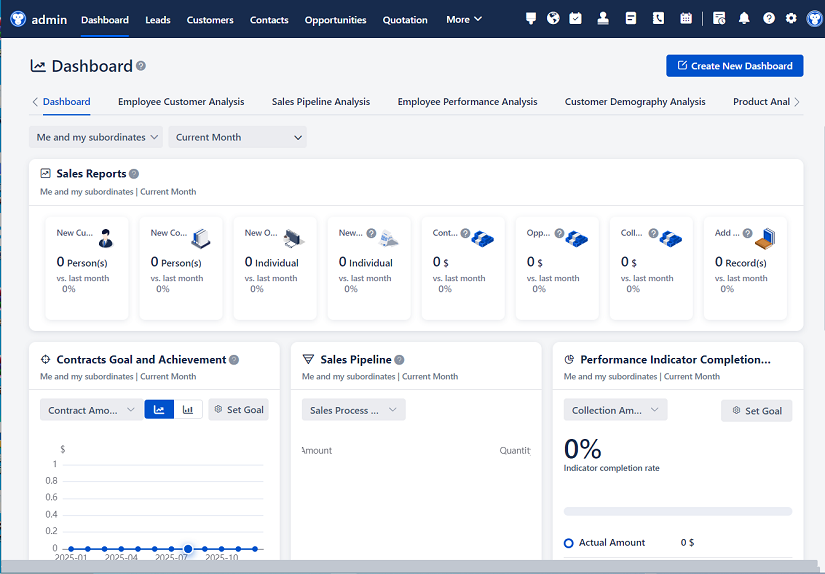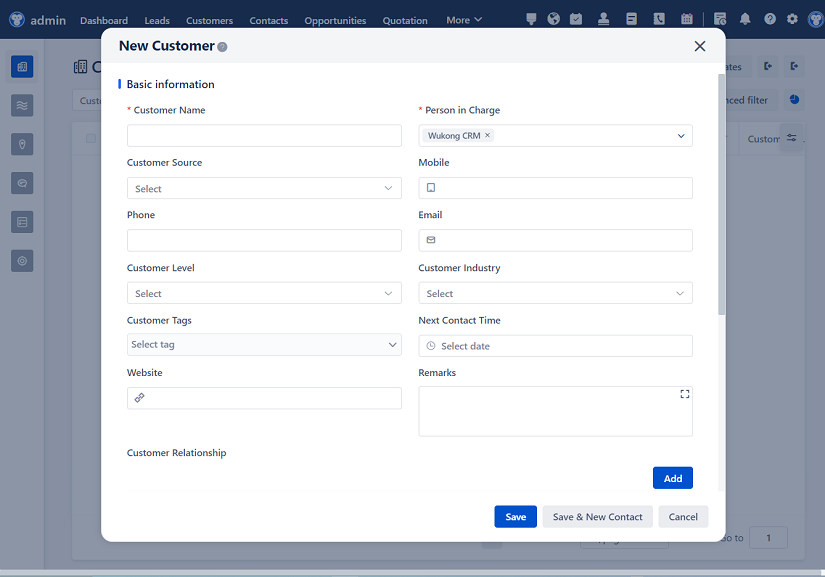
△Click on the top right corner to try Wukong CRM for free
So, you know, when we talk about CRM systems—Customer Relationship Management platforms—they’re kind of like the backbone of how companies manage their interactions with customers. But here’s the thing: not everyone in a company should have access to everything in the CRM. That’s where permission systems and role allocation come into play. I mean, think about it—would you want your intern seeing sensitive financial data or customer contracts? Probably not. So designing a solid permission system is actually super important.
Let me tell you, from what I’ve seen working with different teams, one of the biggest mistakes people make is setting up permissions too loosely at first. Like, “Oh, just give everyone broad access so they can do their jobs.” Sounds nice in theory, right? But then someone accidentally deletes a whole client list, or worse—someone misuses data. And suddenly, you’ve got compliance issues, angry clients, maybe even legal trouble. Yeah, that’s not fun.
Free use of CRM system: Free CRM
So, how do you avoid that? Well, it starts with understanding who needs to do what in the CRM. You’ve got sales reps, marketing folks, customer support agents, managers, admins… each group has different responsibilities. And honestly, their access levels should reflect that. It’s not about mistrusting people—it’s about protecting the business and making sure workflows run smoothly.

I remember this one company I consulted for. They had over 200 users on their CRM, and guess what? Almost all of them had admin-level access. Can you believe that? One accidental click could’ve wiped out months of sales data. We spent weeks cleaning that up and restructuring roles. Took effort, sure, but it was totally worth it. Now, only three people have full admin rights, and everyone else has exactly what they need—and nothing more.
That’s the core idea behind role-based access control (RBAC), by the way. You define roles—like “Sales Rep,” “Marketing Coordinator,” “Support Agent”—and assign specific permissions to each role. Then, when someone joins the team, you just assign them a role, and boom, they’ve got the right access. No guessing, no over-privileging. It’s clean, scalable, and way safer.

But here’s something people often overlook: roles aren’t set in stone. As teams grow or shift focus, roles need to evolve too. For example, maybe your marketing team starts running lead-gen campaigns directly in the CRM. Suddenly, they need access to lead status fields they didn’t touch before. So you tweak the “Marketing” role permissions. Easy fix, right? But if your system isn’t flexible, you’re stuck either giving too much access or constantly asking IT to manually adjust things. And nobody wants that headache.
Another thing I’ve learned the hard way—permissions shouldn’t just be about “can see” or “can edit.” There are layers. Like, can a user view a record? Edit it? Delete it? Transfer ownership? Export data? Each of these actions should be treated separately. Because let’s be real—letting someone export thousands of customer emails is way riskier than letting them update a phone number.
And don’t forget about data sensitivity. Not all customer info is created equal. A contact name and email might be low-risk, but payment history, contract terms, or personal identification details? Those are high-risk. So ideally, your permission system should allow field-level security. That means you can hide or restrict access to specific fields based on the user’s role. Super useful for compliance with stuff like GDPR or CCPA.
Now, here’s a pro tip: always design with the end-user in mind. I’ve seen systems where the permissions were technically perfect—but users couldn’t do their jobs because they kept hitting access errors. Like, a sales rep trying to log a call but can’t save it because they lack “activity creation” rights. Frustrating, right? So while security matters, usability matters just as much. The best systems strike a balance—secure enough to protect data, but flexible enough to empower employees.
One approach I really like is starting with the principle of least privilege. That means giving users the minimum level of access they need to do their job—and nothing extra. It sounds strict, but it actually reduces risk dramatically. And if someone needs temporary access for a special project? Fine, create a temporary role or use time-bound permissions. Much safer than permanently expanding their access.
Oh, and speaking of roles—don’t go overboard with creating too many of them. I’ve seen organizations with 50+ custom roles. That’s just messy. It becomes impossible to track who can do what. Instead, aim for a few well-defined roles that cover most use cases. You can always add exceptions or sub-roles later if needed. Simplicity wins here.
Another thing to consider: how do you handle role changes? People switch teams, get promoted, or leave the company. Your permission system should make it easy to update or revoke access quickly. Ideally, this should be automated through HR integrations. When someone’s employment status changes in the HR system, their CRM access gets updated automatically. No delays, no forgotten deactivations. Huge win for security.
And let’s talk about audits. Yeah, I know—nobody loves doing audits. But they’re crucial. Regularly reviewing who has access to what helps catch mistakes early. Maybe someone still has access after switching departments. Or a contractor’s account wasn’t deactivated. These things happen. A quarterly audit can prevent big problems down the road.
From a technical standpoint, modern CRM platforms like Salesforce, HubSpot, or Microsoft Dynamics have pretty robust built-in tools for managing permissions and roles. But—and this is a big but—just having the tools doesn’t mean you’re using them right. I’ve seen companies pay top dollar for a CRM but configure permissions poorly. So it’s not about the software; it’s about how you design and manage the system.
Training is another piece of the puzzle. If your team doesn’t understand why permissions matter or how to work within the system, they’ll find workarounds—like sharing login credentials (yikes) or exporting data to spreadsheets (double yikes). So make sure to educate people. Explain not just how to use the CRM, but why certain restrictions exist. When people understand the “why,” they’re more likely to follow the rules.
Also, involve stakeholders early. Talk to department heads, team leads, and key users when designing roles. They know their workflows better than anyone. Maybe the support team needs read-only access to deal stages so they can assist customers without altering sales data. Or maybe regional managers need to see their team’s records but not others’. Getting input upfront saves time and avoids rework later.
Testing is non-negotiable too. Before rolling out a new role or permission change, test it in a sandbox environment. Pretend you’re a new hire—can you access what you need? Are there any gaps? Any unnecessary privileges? Catching issues before they go live is way better than dealing with chaos afterward.
And let’s not forget scalability. What works for a 50-person company might fall apart at 500. So build a system that can grow. Use naming conventions for roles, document your logic, and keep an access matrix—a simple chart showing which roles have which permissions. Future-you will thank present-you when onboarding the next wave of employees.
One last thing—monitoring. Even with great design, things can go wrong. Someone might misuse access, or a bug might expose data. So set up logging and alerts. If someone tries to export 10,000 records at once, you should know about it. Real-time monitoring adds another layer of protection.
Look, designing CRM permission systems isn’t the flashiest part of tech work, but it’s one of the most important. It protects your data, keeps you compliant, and helps teams work efficiently. And when done right, it’s invisible—people don’t even notice it because everything just works.
So, to wrap it up: start with clear roles, apply least privilege, use field-level controls, involve users, automate where possible, audit regularly, and always plan for growth. It’s not about building walls—it’s about creating smart pathways that guide people to do their jobs safely and effectively.
FAQs (Frequently Anticipated Questions):
Q: What’s the difference between a permission and a role in a CRM?
A: Great question! A permission defines a specific action—like viewing, editing, or deleting a record. A role, on the other hand, is a collection of permissions grouped together for a job function—like “Sales Manager” or “Customer Support.”
Q: Can one user have multiple roles?
Yeah, absolutely. In many CRMs, users can be assigned more than one role, especially if they wear multiple hats. Just be careful—combining roles can sometimes give more access than intended, so review the total permissions carefully.
Q: How often should we review CRM permissions?
I’d recommend at least every quarter. But if your company is growing fast or going through organizational changes, you might want to check monthly. Better safe than sorry.
Q: What happens if we give someone too much access by mistake?
No panic, but act fast. Revoke the extra permissions, check logs to see what they accessed, and consider tightening approval processes for future role changes.
Q: Is it okay to share login credentials to make access easier?
Nope. Never. Sharing logins breaks accountability, creates security risks, and violates most compliance standards. If access is too hard, fix the permission system—not the login process.
Q: Should contractors have the same access as full-time employees?
Generally, no. Contractors should only have the access they absolutely need, and only for the duration of their project. Use time-limited roles or guest accounts when possible.
Q: Can AI help manage CRM permissions?
Interesting thought! While AI isn’t widely used for this yet, some advanced systems use machine learning to detect unusual access patterns—like someone suddenly viewing hundreds of records. That’s more about monitoring than assigning roles, though.
Q: What’s the easiest way to start improving our current CRM permissions?
Start small. Run a report of all current users and their roles. Identify obvious mismatches—like interns with admin rights. Then, define 3–5 core roles and gradually migrate users into them. Progress over perfection.

Related links:
Free trial of CRM
Understand CRM software

△Click on the top right corner to try Wukong CRM for free